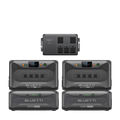Your cart is empty
Shop our productsIf you want to charge your car battery with solar, you’ll need robust panels that can handle a typical 12V battery. You’ll also need other components such as a charge controller. The best part is that the process is straightforward. This article provides a step-by-step guide on how to solar panels to charge a car battery.
What Size Solar Panel Do You Need to Charge a Car Battery?
Since a car battery has a rating of 12V, the size of the solar panel you’ll need will equal that of charging a typical 12V. While there are many solar panels that can charge a car battery, the ideal ought to be to handle your car battery’s voltage, amp hours, and wattage requirements.
And since car batteries come in different capacities ranging from 5 to 200Ah, it is crucial to answer the following questions:
- How fast do you want to charge the battery?
- What is the Ah rating of the car battery?
Answering this question will help you choose the ideal battery. Take a typical car battery with a 100Ah rating as an example. As we have seen, a car battery will have a 12V rating. So, to calculate the energy capacity in watt-hours (Wh), we can use the following formula:
Amp-hour (Ah) x Volts (V) = Watt-hours (Wh)
As such, the 100Ah battery will require a wattage of:
100Ah x 12V = 1200Wh
Let’s say you want your car battery charged within 10 hours. You’ll therefore need a solar panel with at least:
1200Wh / 10 h = 120W
So, to charge your car battery for 10 hours, you’ll need a solar panel with at least 120W. Considering the weather conditions and the battery's efficiency, you will need a solar panel with a higher wattage rating.

For this, you can opt for the BLUETTI PV420 Solar Panel. It has a 420W rating, meaning you can charge your battery’s car within a day or so. And thanks to the long-lasting coating, its sunlight conversion into electricity is bolstered significantly.
You don’t need to install the panel on the roof, instead, you’ll only need to place it where there’s direct sunlight. As a portable solar panel, you can take it with you when camping, hiking, and other outdoor activities. It is easy to transport, thanks to its foldable and portable design.
If you however have a larger car battery, you may need to purchase a panel with a higher rating or add several solar panels. Most EV car batteries will require 4 to 9 solar panels.
When charging your car’s battery, you need to consider aspects such as type of battery, recharge efficiency, and prevailing weather conditions. And when using solar panels, we recommend using a charge controller to avoid damaging the battery.
What Are Car Batteries?
A car battery is one of the most important components of your car. Without it, your car cannot start and electrical components cannot function. When you turn on the ignition key, the battery provides a burst of electrical energy that switches on the electrical components of your car.
The key functions of a car battery are to:
- Regulate and stabilize voltage
- Store extra power produced by the alternator
- Provides energy to start your car
- Provides electrical power to the ignition system
- It works with the alternator to provide power to all electrical components
As you can see, your car’s battery plays a critical role in ensuring efficiency and mobility. Car batteries come in three main types. They include the following:
- Lead-acid batteries are the most popular. They have an outer shell that is filled with battery acid. They are also negative and positive plates that facilitate the transfer of energy. While not the most efficient, their longevity makes them a popular option among car manufacturers.
- Absorbent glass mat (AGM) are efficient but the most expensive. A popular option with military vehicles, it became mainstream in the 1980s, finding its way to everyday cars. The AGM battery consists of a fine fiberglass mat soaked in battery acid. As such, such batteries a spill-proof, making them ideal for off-road vehicles. They are also popular with luxury and sports cars.
- Enhanced flooded batteries (EFB) have a similar build to lead-acid batteries but have better longevity and durability. While expensive, than lead-acid batteries, they are more efficient, making them a favorite option for luxury brands. They are however present in most common cars with stop-start technology.
How to Charge a Car Battery with Solar Panels?
Charging a car battery is similar to charging a 12V battery. What you need is a dedicated solar panel(s) that can produce ample energy to recharge the battery. You’ll also need a charge controller that regulates the flow of electric power from the solar panel.
You can then connect the charge controller to the car battery, ensuring the negative terminal of the controller connects to the negative terminal of the battery. The same case should apply to the positive terminal.
How to Charge 12V Battery?
To charge a 12V battery, you need the following components:
- Solar panels
- 12V battery
- Solar charge controller
- Cables
The charge controller is the most crucial component as it regulates electricity flow to the battery. This prevents damage to the battery from overcharging. How? It cuts off the flow once the battery is fully charged.

As you charge your 12V, you may need a solar battery to store extra electric energy. The BLUETTI AC500 + B300S Home Battery Backup is an ideal option. It has a running wattage of 5000W and a surge rating of 10,000W. This ensures you have ample power to run most of your household appliances.
And since it comes in an expandable design, you can add up to 6 expansion batteries, affording you a maximum power output of 18,432Wh. Quite an amount is needed to power an average American home.
To charge the 12V battery, use the following tips:
- Use 16 gauge wires to connect the battery to the charge controller. Attach one end of the wire to the position terminal. Insert the other end of the wire into the charge controller ports and tighten them using a screwdriver.
- Next, connect the solar panel(s) to the charge controller, making sure to connect the positive end of the solar panel to the positive end of the controller and vice versa. If you’ll be connecting several solar panels, you’ll need a solar connector to connect the panels.
- With the battery, charge controller, and solar panel connected, it is time to test the connection. Turn on the power system and the battery. If the connection is correct, the controller should turn on. Otherwise, you’ll need to rewire everything.
- Finally, position the solar panel(s) where there’s direct sunlight. You can place them on top of your car or on a level ground. The point is to ensure they are receiving ample sunlight.
Related articles: Can You Charge Electric Cars with Solar Panels?
Can You Charge an Electric Car with a Portable Solar Panel?
Using Electric Cars to Power Your Home
How Many Solar Panels Do You Need to Charge a 12V Battery?
The number of solar panels needed to charge your 12V will depend on the panel’s rated power output. As we’ve seen a typical 100W solar panel can charge a 12V battery in a day or two.
However, if you want fast charging or more power, you’ll need to buy extra solar panels. This will help you build a robust solar array. And since you’ll producing more power than needed, you can invest in a power station such as the BLUETTI EP500 Solar Power Station.

This movable power station has a 5100Wh capacity meaning you can store enough energy to power your crucial appliances. What’s more, it has a 2000W rated power ideal for small and large appliances such as laptops, dishwashers, and refrigerators.
How Many Amps Does a 100-Watt Panel Produce?
Amps or ampere is the measure of the electromagnetic force between two points in an electric conductor. To calculate amps you need to divide watts by volts. So, if your panel is rated 12V and 100W, it will produce 8.3A in ideal conditions.
The amperage produced per hour will be 100W / 12V = 8.33A. Therefore, a 100-watt panel can produce approximately 8.3 amps under optimal conditions.
How Long Will It Take to Charge a Battery?
The time it takes to charge a battery depends on several factors such as the weather. If there’s ample direct sunlight, the charging time will be less. Conversely, it might take a day or two to charge your battery when there’s little sunlight.
The state of the battery also affects the charging time. If the battery is completely drained, it might take anywhere from 5 to 8 hours. You should also consider the solar panel’s position. Place it where sunlight shines directly on the panels and the charging time will shorten.
Final Thoughts
Charging your car battery with solar panels is as easy as using a solar panel, charge controller, 16-gauge cables, and connectors. If possible, you should use the MPPT charge controller for best results. BLUETTI solar panels are your best bet for charging your car battery.
Shop products from this article
Be the First to Know
You May Also Like

What Does a 30% Federal Solar Tax Credit Mean and How to Apply?
Governments around the world are offering programs that encourage homeowners to switch to solar energy. Among the most notable programs is the 30% Federal Solar Tax Credit. It reduces your...

Deadly Flooding Devastates U.S. South and Midwest — What You Need to Know












































































































































































































































